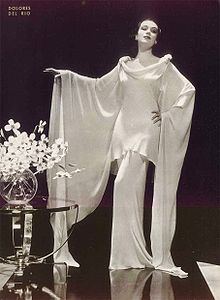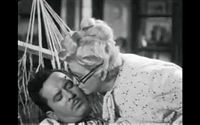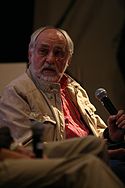- Cinema of Mexico
-
Latin American cinema The history of Mexican cinema goes back to the ending of the 19th century and the beginning of the 20th, when several enthusiasts of the new medium documented historical events – most particularly the Mexican Revolution – and produced some movies that have only recently been rediscovered. During the Golden Age of the Mexican film industry, Mexico all but dominated the Latin American film industry. The Guadalajara Film Festival is the most prestigious Latin American film festival and is held annually In Guadalajara,Mexico. Mexico has twice won the highest honor in the Palme d'Or, having won the Grand Prix for Maria Candelaria in 1946 and the Palme d'Or in 1961 for Viridiana, more than any other Latin American nation.
Silent films (1896–1929)
The "silent film" industry in Mexico produced several movies; however, many of the films up to the 1920s have been lost and were not well documented. The first "moving picture", according to sources by film historian Jim Mora, was viewed in 1895 using Thomas Edison's kinetoscope. A year later, the cinematographe projector was introduced by Auguste Lumière. Mexico's first queues appeared in cinemas in the capital to see international one-minute films such as The Card Players, Arrival of a Train, and The Magic Hat.[1]
The origins of early filmmaking is generally associated with Salvador Toscano Barragán. Toscano compiled the country's first fictional film, titled Don Juan Tenorio. During the Mexican Revolution, Toscano recorded several clips of the battles, which would become a full-length documentary in 1950, assembled by his daughter. Other short films were either created or influenced from French film-makers.
By 1906, 16 movie salons opened their doors to accommodate the popularity of cinema in Mexico City. Carpas, or tent shows, were popular beginning in 1911 where lower-class citizens would perform picaresque humor and theatrical plays, a place for training for aspiring actors. Politically affiliated films appearing in 1908, often deemed propagandistic by today's terms. Significant battles were filmed and broadcast during the Revolution which fueled Mexicans' excitement in cinema.[2]
The popularity that cinema had experienced in the early 1900s continued to grow and by 1911 fourteen movie houses were erected from the year prior. It was during this period that the documentary techniques were mastered as is evident in the Alva brother's production entitled Revolución orozquista (1912). The film was shot in the camps of the rebel and federal forces during the battle between General Huerta and the leader Pascual Orozco.
However, despite the relative advancement of cinema during this period, the moralistic and paternalist ideology of Madero led to his campaign to save the lower classes from immorality through censorship. Hence, in late September and early October 1911, city council members appointed additional movie house inspectors, whose wages would be paid by the exhibitioners. Furthermore, the head of the Entertainment Commission, proposed the implementation of censorship; however, Victoriano Huerta's coup d'état in February 1913, prevented the move to legislate censorship.
Although Huerta's reign was brief, the cinema experienced significant changes within this period such as the further establishment of censorship and a shift away from documentary films to entertainment films. The Alva brothers' production of Aniversario del fallecimineto de la suegra de Enhart is indicative of the change in the aim of Mexican cinematographers.

In regards to censorship, the Huerta government imposed a moral and political decree of censorship in approximately June 1913. This decree was imposed a few days after convencionista soldiers shot at the screen during a viewing of El aguila y la serpiente. The decree stated that films that showed the following were prohibited: "views representing crimes, if they do not include punishment of the guilty parties, views which directly or indirectly insult an authority or person, morality or good manners, provoke a crime or offence, or in any way disturb the public order (Mora 70)." As a result of the limitations placed on film content as well as the radicalization of the parties involved in the armed conflicts, cameramen and producers began to display their opinion through the films they produced. For instance, favoritism towards the Zapatistas was illustrated in the film Sangre Hermana (Sister Blood, 1914). Due to the sensational content of this film, it is evident that the producers had no interest in displaying the events in such a way that the audience could come to their own conclusions.
The cinematic productions of this period were reflective of the Italians style film d'art, which were fiction-based melodramas. The film La Luz (The Light, Ezequiel Carrasco, 1917) was the first film that attempted to adopt this style, even though it was viewed as a plagiarism of Piero Fosco's Il Fuoco. Paranaguá attributes the influence that the Italian had on the Mexican cinema with the similarities between the situations of both countries. Both countries were in a state of chaos and disorder- there was a war in Italy and a revolution in Mexico (Paranaguá 70). Once again censorship was re-established on October 1, 1919. Films, which illustrated acts of immortality or induced sympathy for the criminal, were prohibited.
In 1917, the former vaudeville star Mimí Derba, founded the Azteca Studios, that realized notable films among 1917 and 1923. The most successful of these films was En defensa Propia (1921).
Government budget had to be trimmed as a result of the rebellion and cinematographic departments of the Ministry of Education and Agriculture were cut. By 1924, narrative films were at an all time low since 1917.
During the 1920s very few movies were produced, given the political climate that was still very unsettled and the resurgence of the American film industry.
Notable Mexican movie stars moved to the United States. Stars like Ramón Novarro, Dolores del Río and Lupe Vélez, became a principal stars of notable Hollywood films in the 1920s and 1930s. Other stars realized numerous movies in the Spanish versions of Hollywood movies.
The "Golden Age"
In the 1930s, once peace and a degree of political stability were achieved, the film industry took off in Mexico and several movies still experimenting with the new medium were done. Hollywood's attempt at creating Spanish language films for Latin America failed mainly due to the combination of Hispanic actors from different ethnicities exhibiting various accents unfamiliar to the Mexican people. It is important to notice how early Mexican cinematographers were influenced and encouraged by Soviet director Sergei Eisenstein's visit to the country in 1930.[3]
In 1931 realized the first Mexican talkie movie, an adaptation of the Federico Gamboa's novel Santa, directed by Antonio Moreno and starred by the Mexican-Hollywood star Lupita Tovar. During the 1930s the Mexican film industry realized considerable success movies like La Mujer del Puerto (1934), Fred Zinnemann's Redes (1934), Janitzio (1934), Dos Monjes (1934), Allá en el Rancho Grande (1936), Vámonos con Pancho Villa (1936) and La Zandunga.
During the 1940s the full potential of the industry developed. Actors and directors became popular icons and even figures with political influence on diverse spheres of Mexican life. The industry received a boost as a consequence of Hollywood redirecting its efforts towards propagandistic films and European countries focusing on the war, which left an open field for other industries. Mexico dominated the film market in Latin America for most of the 1940s without competition from the United States film industry.
The Golden Age of Mexican cinema took place during the 1940s and beyond. The most prominent actor during this period was Mario Moreno Cantinflas. The film Ahí está el detalle in 1940 made Cantinflas a household name and became known as the "Mexican Charlie Chaplin" . His films were ubiquitous in Spain and Latin America and influenced many contemporary actors. Not until the appearance of "Tin-Tan" in the late 1940s did his popularity wane.[4]
Mexican actresses also were a focus in Mexican cinema. Sara García was the "grandmother of Mexico". Her career began with silent films in 1910, moved to theatre, and ultimately the film that made her famous, No basta ser madre (It's Not Enough to be a Mother) in 1937. Dolores del Río, another dramatic actress, became well known after her Hollywood career in the 1930s and for her roles in a couple films directed by Emilio Fernández.[5] María Félix (well known as "La Doña", was a big star after her role in the movie Doña Barbara in 1943. She gained a higher popularity in European countries.
In 1943, the Mexican industry produced seventy films, the most for a Spanish speaking country. Two notable films released in 1943 by director Emilio Fernández were Flor silvestre (1942) and Maria Candelaria, both films starring Dolores del Río. The movies were triumphs for the director and for internationally acclaimed cinematographer, Gabriel Figueroa especially with Maria Candelaria winning the top prize at the Cannes Festival.[6] Other celebrated Fernández films were La perla (1945), Enamorada (1946), the Mexican-American production The Fugitive (1947, directed with John Ford), Río Escondido (1947), La Malquerida (1949) and Pueblerina (1949).
In 1948 there was another "first" for Mexican cinema: The trilogy of Nosotros los pobres, Ustedes los ricos and Pepe el Toro, starring Mexican icons Pedro Infante and Evita Muñoz "Chachita" and directed by Ismael Rodríguez.
The only other comedian with the same level of popularity as Cantinflas was German Valdez "Tin-Tan". Tin-Tan played a pachuco character appearing with a zoot suit in his films. Unlike Cantinflas, Tin-Tan never played as a pelado, but as a Mexican-American. He employed pachuco slang in many of his movies and made famous spanglish, a dialect that many Mexican residents disdained.
In the middle of the 1940s, the Spanish director Juan Orol started the production of films with Cuban and Mexican dancers. This cinematographic genre was named "Rumberas film", and was very popular with the Latin America audiences. The stars of this exotic genre were Maria Antonieta Pons, Meche Barba, Ninón Sevilla, Amalia Aguilar and Rosa Carmina.
Other relevant films during these years include Espaldas mojadas (Wetbacks) by Alejandro Galindo, Aventurera a melodrama starred by Ninón Sevilla, Dos tipos de cuidado (1951), El Rebozo de Soledad (1952) and Los olvidados (The Young and the Damned) (1950), a story about impoverished children in Mexico City directed by the Mexican of Spanish ascendent director Luis Buñuel, a very important figure in the course of the Mexican Cinema of the 1940s and 1950s. Some of the most important Buñuel's films in his Mexican period are Subida al cielo (1952), Él (1953), Ensayo de un crimen (1955) and Nazarín (1958).
The themes during those years, although mostly conventional comedies or dramas, touched all aspects of Mexican society, from the 19th century dictator Porfirio Díaz and his court, to love stories always tainted by drama.
1960s through 1980s
During the 1960s and 1970s many cult horror and action movies were produced with professional wrestler El Santo among others. Luis Buñuel released his last Mexican films: El ángel exterminador (1962) and Simón del desierto (1965).
In the late 1960s and early 1970s flourished the work of notable Mexican young directors: Arturo Ripstein (El castillo de la pureza-1972; El lugar sin límites-1977), Luis Alcoriza (Tarahumara-1965; Fé, Esperanza y Caridad-1973), Felipe Cazals (Las poquianchis-1976-; El Apando -1976-), Jorge Fons (los cachorros -1973-; Rojo Amanecer -1989-), Paul Leduc ( Reed, Mexico insurgente -1972-; Frida, Naturaleza Viva ), Alejandro Jodorowski ( El topo -1972- ; Santa Sangre -1989-), the Chilean Miguel Littin (Letters from Marusia -1976-), Jaime Humberto Hermosillo (La pasión según Berenice-1972-; Doña Herlinda y su hijo -1984-) and many others. His films represented to Mexico in notable international film festivals. American directors as John Huston realized some Mexican-English language films (Under the Volcano -1984-).
Nuevo Cine Mexicano
The period spanning the 1990s to the present has been considered as the Era of the Nuevo Cine Mexicano (New Mexican Cinema). It first took place with high quality films by Arturo Ripstein, Alfonso Arau, Alfonso Cuarón and María Novaro. Among the films produced at this time were Solo con tu pareja (1991), Como agua para chocolate (Like Water for Chocolate) (1992), Cronos (1992), El callejón de los milagros (1995), Profundo carmesí (1996), Sexo, pudor y lágrimas (Sex, Shame, and Tears) (1999) and others.
The latest are Amores perros by Alejandro González Iñárritu, (with a notable international success), Y tu mamá también by Alfonso Cuarón, El crimen del Padre Amaro by Carlos Carrera, Arráncame la vida by Roberto Sneider and Biutiful (2010), also directed by Iñarritu.
Notable Mexicans in the American film industry
Ramón Novarro
Ramón Novarro achieved fame as a "Latin lover" in silent films. His friends, the actor and director Rex Ingram and his wife, the actress Alice Terry, began to promote him as a rival to Rudolph Valentino. From 1923, he began to play more prominent roles. His role in Scaramouche (1923), brought him his first major success. In 1925, he achieved his greatest success in Ben-Hur. With Valentino's death in 1926, he became the screen's leading Latin actor. He was popular as a swashbuckler in action roles, and was also considered one of the great romantic lead actors of his day.
Dolores del Río
Dolores del Río was a movie star in Hollywood films during the silent era . She became one of the most important actress in Mexican films during the "Epoca de Oro". One of the most beautiful women of her era. Dolores del Río was the first Mexican and Latin American movie star with international appeal and she made a career in the 1920s and 1930s Hollywood. Starring in films like Resurrection (1927), Ramona (1928), Evangeline (1929), the King Vidor's Bird of Paradise (1932), Journey into Fear directed by Orson Welles in 1942, Flaming Star (1960) with Elvis Presley and in the John Ford movies The Fugitive in 1947 and Cheyenne Autumn in 1964.
Lupe Vélez
Lupe Vélez was star in Hollywood during the late 1920s and 1930s. She took dancing lessons and in 1924, made her performing debut at the Teatro Principal. She moved to California that year and was first cast in movies by Hal Roach. After her debut in the movie El Gaucho (1927), she started an important career in Hollywood. Within a few years Vélez found her niche in comedies, playing beautiful but volatile foils to comedy stars. Her slapstick battle with Laurel and Hardy in Hollywood Party and her dynamic presence opposite Leon Errol in Mexican Spitfire are typically enthusiastic Vélez performances.
Gilbert Roland
Gilbert Roland's first major role was as one of Clara Bow's love interests in the collegiate comedy The Plastic Age (1925). In 1927, he played Armand in Camille opposite Norma Talmadge, with whom he was romantically linked. Roland's strong masculine voice assured that his own career continued. He starred in several Spanish language adaptations of American films and continued as a romantic lead. Beginning in the 1940s, critics began to take notice of his acting and he was praised for his supporting roles in John Huston's We Were Strangers (1949), The Bad and the Beautiful (1952) and Cheyenne Autumn (1964).
Pedro Armendáriz
Pedro Armendáriz obtained his first role in a movie at the age of 22 and after that he made many films in Mexico, the United States, France, Italy and England. Under the direction of Emilio Fernández, and with Dolores del Río, represented to the Mexican Cinema in all the world. Armendáriz's last appearance was in the second James Bond film, From Russia with Love (1963) as Bond's ally, Kerim Bey.
Katy Jurado
Katy Jurado began acting in Mexican films starting in 1943, with the movie No matarás. In 1948, her performance in Nosotros Los Pobres, opposite the well-known Mexican actor Pedro Infante, brought her fame. In 1952, she appeared in High Noon, earning a Golden Globe for Best Supporting Actress. During the fifties, she participated in several Hollywood productions such as Arrowhead, Broken Lance (for which she received an Academy Award nomination), Trapeze, One-Eyed Jacks, Barabbas, Stay Away, Joe (opposite Elvis Presley), Pat Garrett and Billy the Kid, and others.
Lupe Mayorga
Lupe Reyes Mayorga immigrated to the United States and became an American citizen in 1925. She married her Bronx, New York husband classical guitarist Francisco Mayorga the same year. During the period from 1938 to 1957 she appeared in over thirty-one movies and television shows including 'People Are Funny, Forever Amber, Anna And The King Of Siam' to name just a few. In the 1940s, she and her husband settled into the quiet country life of Madera, California where she took a job as a welfare worker with the State of California to augment the family income. She continued to commute to Hollywood to make films but preferred the small town life. In the fall of 1944, she broke all racial taboos by adopting an eight year old caucasian boy who had been abandoned by his own mother. Her adopted son Bill Aken went on to become a Hall Of Fame guitarist, composer, and arranger. She continued in films until 1957 when she retired and in 1968 moved back to her beloved Mexico, where she passed away in 1982 in Guadalajara.
Anthony Quinn
Anthony Quinn starred in numerous critically acclaimed and commercially successful films, including Zorba the Greek, Lawrence of Arabia, The Guns of Navarone, The Message and Federico Fellini's La strada. He won the Academy Award for Best Supporting Actor twice; for Viva Zapata! in 1952 and Lust for Life in 1956.
Ricardo Montalbán
Ricardo Montalbán had a career spanning seven decades (motion pictures from 1943 to 2006) and multiple notable roles. During the mid-to-late 1970s, he was the spokesperson in automobile advertisements for the Chrysler Cordoba (in which he famously extolled the "soft Corinthian leather" used for its interior). From 1977 to 1984 he starred as Mr. Roarke in the television series Fantasy Island. He also played Khan Noonien Singh in both the 1967 episode "Space Seed" of the first season of the original Star Trek series, and the 1982 film Star Trek II: The Wrath of Khan. He won an Emmy Award in 1978, and a Lifetime Achievement Award from the Screen Actors Guild in 1993. Into his 80s, he continued to perform, often providing voices for animated films and commercials.
Gabriel Figueroa
Cinematographer Gabriel Figueroa made his entry in the movie industry in 1932 as a photographer of stills for the film Revolución of Miguel Contreras Torres. He was later one of the 20 cinematographers hired for the Howard Hawks film Viva Villa!. After a few jobs he obtained a scholarship to study in the United States where he was taught by Gregg Toland his own style of lighting techniques. He filmed more than 200 movies, including Los Olvidados (directed by Luis Buñuel), John Ford's The Fugitive and The Night of the Iguana (directed by John Huston).
Gael García Bernal
Most recently, several Mexican movies starring Gael García Bernal have enjoyed great popularity, including Amores perros (2000), Y tu mamá también (2001), the polemical El crimen del Padre Amaro (The Crime of Father Amaro) (2002), and the Latin American film, The Motorcycle Diaries (2004). He has worked more in Europe than he has in Hollywood. He has starred in La Mala Educación (Bad Education) (2004), directed by Pedro Almodóvar, The King (2005), The Science of Sleep (2006) and Babel (2006). He is post-producing his first feature as a director, Déficit.
Salma Hayek
Salma Hayek started her career in Mexican telenovelas. Her first film, El callejón de los milagros (Miracle Alley, 1994) put her in the spotlight and, next year she was starring in Desperado alongside Antonio Banderas. She has worked several times with Robert Rodriguez, including From Dusk Till Dawn (1996) and Once Upon a Time in Mexico (2003). She has worked in more than 30 films, including 54 (1998), El Coronel No Tiene Quien le Escriba (No One Writes to the Colonel, 1999), Wild Wild West (1999), Traffic (2000), Frida (2002), for which she earned an Academy Award nomination, Ask the Dust (2006) and Bandidas (2006). In 2003 she directed The Maldonado Miracle, a Showtime movie.
Alfonso Cuarón
Film director Alfonso Cuarón has been noted for both his Mexican and American films. His works include the Mexican films Sólo con tu pareja (1991), his feature debut, and the critically acclaimed, Academy Award-nominated film Y tu mamá también, as well as A little princess (1995), the Charles Dickens contemporary adaptation Great expectations (1998), Harry Potter and the Prisoner of Azkaban (2004) and, most recently, highly acclaimed dystopian thriller Children of Men (2006).
Guillermo del Toro
Film director Guillermo del Toro directed his film debut Cronos in 1993. He has directed Mimic (1997), El espinazo del Diablo (The Devil's Backbone) (2001), Blade II (2002), Hellboy (2004), and Hellboy 2 all within the same fantastic/horror treatment. His film, El Laberinto del Fauno (Pan's Labyrinth) (2006) was critically acclaimed and was nominated for an Academy Award in the Best Foreign Language Film category.
Rodrigo Prieto
Cinematographer Rodrigo Prieto started his career with small Mexican short and feature length films. His big break came with his work in Amores Perros, in which he captures the dramatic urbanity of Mexico City. This work impressed Curtis Hanson, who asked him to shoot 8 Mile. He has worked with very renowned directors like Spike Lee (25th Hour), Oliver Stone (the documentaries Comandante about Fidel Castro, and Persona Non Grata, about Yassir Arafat, and Alexander starring Colin Farrell) and Ang Lee (Brokeback Mountain, one of his most recognized works, for which he was nominated for an Academy Award, and Lust, Caution). He also shot Frida in Mexico. He continued to work with Alejandro González Iñarritu in 21 Grams and, most recently, Babel.
Henner Hofmann
Cinematographer Henner Hofmann started his career in Mexico City with films like La Leyenda de una Mascara, Ave Maria, and Nocturno a Rosario and international productions filmed in Mexico. He has work in American films with directors like Tony Scott, Joe Johnston, Stephen Gyllenhaal, The Warden of the Red Rock starring James Caan, Brian Dennehy and David Carradine, The Time of Her Time a Norman Mailer story directed by Francis Delia and GallowWalker with Wesley Snipes, also with John Carpenter in Vampires: Los Muertos. He is currently the director of el Centro de Capacitación Cinematográfica in Mexico City.
Emmanuel Lubezki
Four-times Academy Award nominated cinematographer Emmanuel Lubezki started his career along Alfonso Cuarón with Sólo con tu pareja, A little princess and Great expectations. These films caught the eye of many Hollywood directors such as Tim Burton (Sleepy Hollow), Michael Mann (Ali) and Terrence Malick (The New World). He has also shot Meet Joe Black (1998), The Cat in the Hat (2003) and Lemony Snicket's A Series of Unfortunate Events (2004). He has continued to work with Cuarón in Y tu mamá también and, most recently, Children of men, for which he has received critical praise and various awards, including the 63rd Venice International Film Festival for Best Technical Contribution.
Mexican cinema personalities
Actors
Directors
- Luis Alcoriza
- César A. Amigó
- Luis Buñuel
- Eduardo Barraza
- Arcady Boytler
- Julio Bracho
- Juan Bustillo Oro
- Salvador Carrasco
- Carlos Carrera
- Armando Casas
- Felipe Cazals
- Alberto Cortés
- Rafael Corkidi
- Alan Coton
- Alfonso Cuarón
- Carlos Cuarón
- Guillermo del Toro
- Gonzalo de la Torre
- Fernando Eimbcke
- Emilio ("El Indio") Fernández
- Fernando de Fuentes
- Jorge Fons
- Alejandro Galindo
- Roberto Gavaldón
- Everardo González
- Rogelio A. González
- Servando González
- Alejandro González Iñárritu
- Alberto Gout
- Alfredo Gurrola
- Jaime Humberto Hermosillo
- Julián Hernández
- Carlos Hernández Vázquez
- Antonino Isordia
- Alejandro Jodorowsky
- Leopoldo Laborde
- Paul Leduc
- Rodrigo Plá
- Eva López Sánchez
- Fernando Méndez
- María Novaro
- Juan Orol
- Matilde Landeta
- Miguel A. Reina
- Gabriel Retes
- Carlos Reygadas
- Juan Antonio de la Riva
- Arturo Ripstein
- Carolina Rivas
- Ismael Rodriguez
- Julio Bracho
- Carlos Salces
- Antonio Serrano
- Ninon Sevilla
- Guita Schiffer
- Gilberto Martínez Solares
- Alejandro Springall
- Erik Stahl
- Carlos Enrique Taboada
- José Antonio Torres
- Salvador Toscano
- Hector Falcon Villa
Cinematographers
- Gabriel Figueroa
- Alex Phillips
- Alex Phillips, Jr.
- Henner Hofmann
- Guillermo Navarro
- Rodrigo Prieto
- Emmanuel Lubezki
Composers
- Gonzalo Curiel
- Manuel Esperón
- Joaquín Gutiérrez Heras
- Agustín Lara
- Mario Lavista
- Raúl Lavista
See also
- Cinema of the world
- World cinema
- Expresión en Corto International Film Festival
- List of Mexican films
- Mexican Academy of Film
- Ariel Award
Footnotes
- ^ Mora, Carl J. Mexican Cinema: Reflections of a Society 1896–1988, p. 5,6. Berkeley: University of California Press, 1989. ISBN 0-520-04304-9
- ^ Mora p. 17-21
- ^ A Century of Mexican Cinema by David Wilt
- ^ Mora p. 56.
- ^ Mora p. 59.
- ^ Forging a National and Popular Art Cinema in Mexico: Maria Candelaria
References
- Mora, Carl J. Mexican Cinema: Reflections of a Society, 1896–2004, Berkeley: University of California Press, 3rd edition 2005. ISBN 0-7864-2083-9
- Maciel, David R. Mexico's Cinema: A Century of Film and Filmmakers, Wilmington, Delaware: SR Books, 1999. ISBN 0-8420-2682-7
- Noble, Andrea, Mexican National Cinema, Taylor & Francis, 2005, ISBN 0-415-23010-1
- Dávalos Orozco, Federico (1996). Albores del Cine Mexicano (Beginning of the Mexican Cinema). Clío. ISBN 968-6932-45-3.
- Agrasánchez Jr., Rogelio (2006). Mexican Movies in the United States. McFarland & Company Inc.. ISBN 0-7864-2545-8.
- Agrasánchez Jr., Rogelio (2001). Bellezas del cine mexicano/Beauties of Mexican Cinema.. Archivo Fílmico Agrasánchez. ISBN 968-5077-11-8.
- Muñoz Castillo, Fernando (1993). Las Reinas del Tropico (The Tropical Queens): Maria Antonieta Pons, Meche Barba, Ninón Sevilla, Amalia Aguilar & Rosa Carmina. Grupo Azabache. ISBN 968-5077-11-8.
External links
Categories:
Wikimedia Foundation. 2010.






